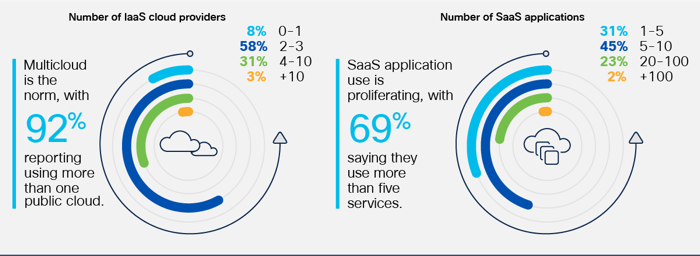What do you get when a massively distributed workforce tries to securely connect to a massively distributed set of applications? Massive complexity. In light of this, our latest annual Global Networking Trends Report is focused on how IT leaders and networking professionals are dealing with the challenges of connecting their increasingly dispersed workers to their increasingly distributed applications. And coming as a surprise to no one, when 2,500 IT leaders and professionals across 13 countries were surveyed, they verified that these challenges were their number one networking priority for 2023.
In addition to presenting the key trends from the survey results, the report includes six areas of essential guidance—guidance that focuses on one ultimate outcome: how best to provide distributed workforces with consistent, secure, anywhere connectivity to applications in a multicloud environment. We also asked Cisco experts to share their point of view on how organizations should implement this essential guidance. Here are a few points I found particularly interesting.
Use of Multiple Clouds is on the Rise
The report validates that organizations are, indeed, moving more of their apps and workloads to multiple cloud providers. But a bigger revelation was just how many different cloud providers organizations are using: 92% use more than two and an incredible 34% host workloads with more than four cloud providers (Figure 1). At the same time, one in four are using more than 20 SaaS applications. And when asked why, many respondents identified agility as the biggest motivation for moving to multiple cloud services, citing it as more important than either cost or resilience.

Lack of Operational Consistency is an Obstacle
The report found that two in five respondents cite lack of consistency across networking, security, and cloud domains as a big obstacle to securely connecting users to cloud resources. At the root of this problem is the reality that many IT organizations still have network and security teams that plan and operate independently. This leaves many IT leaders challenged when trying to deliver better and more secure user experiences with their existing technology and divided operational boundaries.
Integrate Networking and Security from Device to Cloud
Almost half of the respondents identified a fully integrated networking and security architecture in the form of Secure Access Service Edge (SASE) as their primary choice for connecting branches and remote users to multicloud applications within the next two years. They reported widespread plans to integrate cloud-based software-defined WAN (SD-WAN) connectivity and cloud security in order to deliver consistent secure access to both SaaS– and IaaS–based services.
Simplify Connectivity to Multiple Clouds
As the number of clouds increases, the ability to provide consistent and efficient connectivity management and security across them is becoming increasingly important. To improve connectivity to cloud-based applications from all locations, 53% of respondents said they are prioritizing SD-WAN integration with cloud services, SaaS, and middle-mile providers (Figure 2). Why? To apply policy consistently, automate connectivity, and better secure the application experience.

You Can’t Manage What You Can’t See
Ultimately responsible for end-user experiences, IT is increasingly challenged to deliver desired levels of service. With the majority of transactions either originating or terminating outside of traditional enterprise boundaries, IT lacks visibility into the full network path. The digital supply chain is increasingly complex, composed of multiple providers and hops that are typically invisible to IT teams. With the Internet increasingly becoming the new core network, it’s no wonder that IT teams need help. In response to this need for greater visibility, 51% of IT professionals reported prioritizing the adoption of end-to-end network telemetry and visibility to achieve proactive detection and remediation of issues.
Guiding, influencing, or implementing your own organization’s direction for networking is no easy feat. Explore this year’s report to learn more about how your peers are connecting and securing their increasingly distributed personnel to increasingly distributed apps and data.
What is your SASE strategy? What does your own journey look like?
Find out more in the 2023 Global Networking Trends Report


Is CSCO, at all, involved w any AL business ?